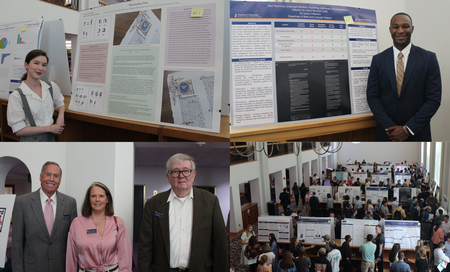
Samford University’s Davis Library buzzed with intellectual energy on Friday, April 25 as students from across disciplines shared their academic findings at the 2025 Student Research Colloquia (SSRC). Hosted in partnership by the Research Advisory Collaborative and the Office of Research, the annual event served as a public forum for both undergraduate and graduate students to present original research across two poster sessions.
More than 100 posters were featured throughout the morning, underscoring the breadth of scholarship taking place at Samford. Projects ranged from data-driven STEM inquiries to in-depth explorations in the humanities. The event gave students the opportunity to hone their communication skills, collaborate with faculty mentors and contribute to the scholarly conversation within their fields.
Samford’s Howard College of Arts and Sciences was well represented, with students and faculty from a variety of disciplines contributing to the program.
Among those featured was Emma Mikell, a senior English and classics double major from Covington, Louisiana, whose project Illuminating Finds: How Decoding the Paleographic Intricacies of Medieval Manuscripts Helps Keep History Alive One Letter at a Time explored the origins of a 15th-century Latin manuscript fragment housed in Davis Library.
“Samford has a piece of history with this manuscript,” Mikell said. “It is significant for us because we normally don't have the chance to showcase the research being done by students from Howard College. I am so honored to be working with this living piece of history.”
Working alongside Anthony Minnema, associate professor of history, Mikell used paleographic techniques to trace the manuscript’s provenance and link it to Johannes Versoris, a 15th-century scholar at the University of Paris.
“This is one of the best things that happens at Samford all year,” Minnema said. “The range of work that people can do within our college is remarkable. I am so proud of Emma—not only for the research she’s done but for presenting it in such a clear and compelling way. She demonstrates the depth and humanity of the work being done at Samford.”
Also presenting was Quincy Crittendon, a senior computer science major from Decatur, Alabama. His project, Red-Teaming Large Language Models: An Exploration of Jailbreaks and Adversarial Attacks, examined how artificial intelligence systems can be manipulated to bypass safety mechanisms.
“This is a great opportunity,” Crittendon said. “It’s beautiful to see all these students and the hard work we’ve put in. I’ve grown as a developer through this process. We’re all passionate, and it’s a great feeling to see our work on display.”
The SSRC continues to serve as a launchpad for academic exploration and professional development at Samford. As students including Mikell and Crittendon demonstrated, research is not only a pursuit of knowledge but a way to deeply engage with the world—whether through the lens of a medieval manuscript or the ethics of emerging technologies.
GIVE: Support impactful work at Howard College of Arts and Sciences.
